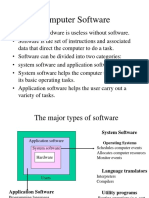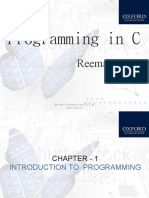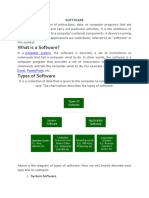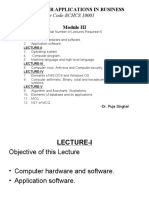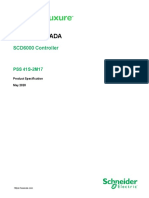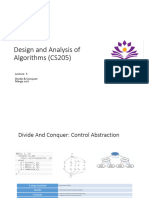0 ratings0% found this document useful (0 votes)
47 viewsIntroduction To Software
Uploaded by
mishraayushi2002Copyright
© © All Rights Reserved
Available Formats
Download as PPTX, PDF, TXT or read online on Scribd
0 ratings0% found this document useful (0 votes)
47 viewsIntroduction To Software
Uploaded by
mishraayushi2002Copyright
© © All Rights Reserved
Available Formats
Download as PPTX, PDF, TXT or read online on Scribd
You are on page 1/ 19
• Introduction of Software:-
• Software: Software is a collection of program.
• Program: Program is a collection of instruction.
• Instruction:- Instruction is a collection of alphabet, number and
special symbol etc.
Computer software or simply software, is a collection
of data or computer instructions that tell the computer how to
work. This is in contrast to physical hardware, from which the
system is built and actually performs the work. In computer
science and software engineering, computer software is
all information processed by computer
systems, programs and data. Computer software
includes computer programs, libraries and related non-
executable data, such as online documentation or digital media.
Computer hardware and software require each other and
• Or
• Computer software, or simply software,
• is a kind of programs that enable a
• user to perform some specific task or
• used to operate a computer.
• It directs all the peripheral devices on
• computer system - what to do and how
• to perform a task. PC Software plays
• a role of mediator between user
• and computer hardware.
• Without Software, a user can’t perform
• any task in digital computer.
• A computer system can be divided into three components: the
hardware, software and the users. Software can be further divide
into mainly two parts: Application software and System Software.
Bare use of hardware is not easy, so to make it easy software is
• Example:-Windows operating system
• Office Professional Plus 2016-(Word, Excel, PowerPoint, OneNote, Publisher,
Project, Access, Visio).
• Skype software .
• video chat software .
• web browser software -Google Chrome, Microsoft Internet Explorer software.
• Google Drive File Stream.
• Game application.
• Windows Defender
• Antivirus
• Adobe Acrobat PDF reader, Adobe Flash Player
• Multimedia software
• Oracle Java JRE
• e-learning tool
• computer-aided design
• Driver Software
• Database software
• Inventory management system .
• Type of Software:-There are two types of software-
• 1. Application software
• 2. System software
• Other type of software known as -Firmware and Freeware.
• This type of software is available at no cost to users. It can be
downloaded from the internet or distributed on physical media like a
flash drive
• 1. Application Software:- Applications software also called end-user
programs or simply an app. It is resides above system software.
Applications software is used by end user for specific purpose. It is a
programmed for simple as well as complex tasks. It either be installed
or access online. It can be a single program or a group of small
programs that is referred to as an application suite.
Application software can be used by user to complete Specific tasks,
such as creating word processors documents, spreadsheets,
Presentation, Graphics, CAD/CAM, sending email etc.
• Application software is also known as end-user software as
this software used by end users to complete their task.
There are two types of application software as follows.
a) Basic application software
b) Specialized application software
• These are some types of software which we can use in our
pc for work. Also if you are creating your own software you
can easily Sell software online on e commerce websites.
• Types of Application Software:-
• There are two types of application software –
• 1. General Purpose software
• 2. Specific purpose software
• (B) Special purpose Application Software – Special
application software are created to satisfy specific
needs of an organization are hired to create such
software. The cost of such in this case software
engineers software depends upon the extent of
work automated through software. Example are
payroll software, inventory control software, railway
reservation software etc.
• System Software:- System software directly interact to hardware part of
computer or machine. System Software (type of computer program) provides a
platform to run computer’s hardware and computer application to utilize system
resources and solve their computation problem. It is written in a low-level
language like assembly language so it can easily interact with hardware with
basic level. It control working of peripheral devices. System software act as a
scheduler for the execution of the processes and arrange the sequence
according to their priority and I/O devices requirement and creation of process.
The best-known example of system software is the operating system (OS). It
responsible to manages all the other programs in a computer.
Operating system creates an interface between user and hardware and also in
application software and hardware. examples of software are Windows 7,
Windows XP and Windows 10.
Generally user does not interact with the System Software directly. The user
interacts with the GUI created by System Software. Through this GUI user
interact with applications installed in system.
• There are four types of system software as follow-
a) Operating System
b) Utilities program and software
c) Device drivers
• 1. Operating System :-An operating system (OS) is a type of system software that
manages computer’s hardware and software resources. It provides common
services for computer programs. An OS acts a link between the software and the
hardware. It controls and keeps a record of the execution of all other programs that
are present in the computer, including application programs and other system
software.
2. Utility Program-Usually utility software installed during installation of OS. Utility
program help in analyze, configure, secure, optimize and maintain the system. List
of utility program-Disk checker, disk cleaner, disk defragmenter, disk space analyzer,
disk backup etc.
• Or
• It is a system software that performs a specific task which mainly related to the
managements of computer. It is same like tool-kit. Some utilities help you backup
data, some help remove outdated files or recover data that has been erased by
mistake.
• Some important utilities are as followed-
• Text Editor
• Backup Utility program
• Compression Utility
• Disk Defragmenter
• 3. Language Translator-It translate programming
code into the machine code. So, that computer can
understand it and can process further.
Computer converts the High Level Language into
Machine Language (binary language i.e, 0 and 1)
The language processors are given below-
• Assembler
• Interpreter
• Compiler
• 4. Device Driver-A device driver is a software
program that controls a particular types of (or)
specific type of hardware.
• Examples: Sound card driver, video card driver, etc.
• Operating System:-
• An operating system (OS) is a type of system
software that manages computer’s hardware and
software resources. It provides common services for
computer programs. An OS acts a link between the
software and the hardware. It controls and keeps a
record of the execution of all other programs that
are present in the computer, including application
programs and other system software.
• The most important tasks performed by the operating system
are:-
• 1. Memory Management: The OS keeps track of the primary
memory and allocates the memory when a process requests it.
2. Processor Management: Allocates the main memory (RAM)
to a process and de-allocates it when it is no longer required.
3. File Management: Allocates and de-allocates the resources
and decides who gets the resources.
• 4. Device Management(Input /Output):-Device Management in
Operating system manages all the hardware or virtual devices of a
computer. The device management system
allocates input/output devices to the process on the basis of
priority and de allocated as well either temporarily or permanently
depending upon the conditions. The example of device management
like disk, microphone, keyboard, printer, magnetic tape, USB ports,
camcorder, scanner, other accessories, and supporting units like
supporting units control channels.
•
5. Security: Prevents unauthorized access to programs
and data by means of passwords.
6. Error-detecting Aids: Production of dumps, traces,
error messages, and other debugging and error-
detecting methods.
7. Scheduling: The OS schedules process through its
scheduling algorithms.
• Language Translator:
• 1. Compiler : A compiler is a software that translates the
code written in one language to some other language
without changing the meaning of the program. The
compiler is also said to make the target code efficient
and optimized in terms of time and space.
• A compiler performs almost all of the following
operations during compilation: preprocessing, lexical
analysis, parsing, semantic analysis (syntax-directed
translation), conversion of input programs to an
intermediate representation, code optimization and
code generation. Examples of compiler may include
gcc(C compiler), g++ (C++ Compiler ), javac (Java
Compiler) etc.
• 2. Interpreter : An interpreter is a computer program that
directly executes, i.e. it performs instructions written in a
programming or scripting language. Interpreter do not
require the program to be previously compiled into a
machine language program. An interpreter translates high-
level instructions into an intermediate form, which is then
executes.
• Interpreters are fast as it does not need to go through the
compilation stage during which machine instructions are
generated. Interpreter continuously translates the program
until the first error is met. If an error comes it stops
executing. Hence debugging is easy.
• Examples may include Ruby, Python, PHP etc.
• 3. Firmware software :- Firmware is often referred to as
“software for hardware.” firmware is a also part of system
software programming that provides low-level control
of computing device hardware. Or Firmware is a small
software program that is written to Hardware devices in
non-volatile memory.
• All chip level and embedded programming for hardware known
as firmware. Or Firmware is software that provides basic
machine instructions that allow the hardware to function
and communicate with other software running on a device.
• Hardware like cameras, mobile phones, network cards,
optical drives, printers, routers, scanners, and television
remotes rely on firmware built into their memory to
function smoothly.
• 4. Free ware Software:- Freeware software is a
computer software that is available for free,
typically for download from the internet. It's often
proprietary software, meaning that the publisher
defines the rules for its use. Here are some things to
know about freeware.
• 5. Share ware Software:- Shareware is a type of
proprietary software that is initially shared by the
owner for trial use at little or no cost. Often the
software has limited functionality or incomplete
documentation until the user sends payment to the
software developer.
You might also like
- 2020 Fall Competition Case Packet: Traders@mit - Edu Traders - Mit.eduNo ratings yet2020 Fall Competition Case Packet: Traders@mit - Edu Traders - Mit.edu20 pages
- Applicartion Software and System SoftwareNo ratings yetApplicartion Software and System Software28 pages
- Information Communitation Technoloy Notes by Asra NoorNo ratings yetInformation Communitation Technoloy Notes by Asra Noor17 pages
- CS1010 Introduction To Computing: (Computer Software)No ratings yetCS1010 Introduction To Computing: (Computer Software)65 pages
- .Trashed 1723650123 Bca - 1 - Unit IV SoftwareNo ratings yet.Trashed 1723650123 Bca - 1 - Unit IV Software7 pages
- What Is Software ?: Software and Other Is To Prepare A New Program FromNo ratings yetWhat Is Software ?: Software and Other Is To Prepare A New Program From8 pages
- Computer Software: Class Incharge: S.SasirekhaNo ratings yetComputer Software: Class Incharge: S.Sasirekha15 pages
- Lec-1.1 Introduction to System SoftwareNo ratings yetLec-1.1 Introduction to System Software24 pages
- Software Suite: Revolutionizing Computer Vision with the Ultimate Software SuiteFrom EverandSoftware Suite: Revolutionizing Computer Vision with the Ultimate Software SuiteNo ratings yet
- Foxboro™ SCADA SCD6000 Controller - 41s2m17100% (1)Foxboro™ SCADA SCD6000 Controller - 41s2m1725 pages
- This Study Resource Was: Trimester: Trimester 2, 2017/2018No ratings yetThis Study Resource Was: Trimester: Trimester 2, 2017/20184 pages
- Sap C ts452 2021 Dumps by Nicholson 23 06 2022 9qa DumpssheetNo ratings yetSap C ts452 2021 Dumps by Nicholson 23 06 2022 9qa Dumpssheet11 pages
- Snpi - Sow For Time and Materials EngagementNo ratings yetSnpi - Sow For Time and Materials Engagement18 pages
- Silo - Tips - Wiat BV Documentation CenterNo ratings yetSilo - Tips - Wiat BV Documentation Center105 pages
- Managing IBM Lotus Domino 8.5 Servers and UsersNo ratings yetManaging IBM Lotus Domino 8.5 Servers and Users3 pages
- 1.try-It-Out - Function For Fibonacci Series Welcome To To Generate Fibonacci Sequence NewNo ratings yet1.try-It-Out - Function For Fibonacci Series Welcome To To Generate Fibonacci Sequence New3 pages
- Paxton10-Paxlock-Pro-Euro-External-Black-Paxton10 Installer GuideNo ratings yetPaxton10-Paxlock-Pro-Euro-External-Black-Paxton10 Installer Guide28 pages
- Learn Asynchronous JavaScript - Async-Await Cheatsheet - CodecademyNo ratings yetLearn Asynchronous JavaScript - Async-Await Cheatsheet - Codecademy4 pages
- Mohammed TAZIBT: Professional ExperiencesNo ratings yetMohammed TAZIBT: Professional Experiences1 page
- Conversion of Sign Language To Text: For Dumb and DeafNo ratings yetConversion of Sign Language To Text: For Dumb and Deaf26 pages
- 2020 Fall Competition Case Packet: Traders@mit - Edu Traders - Mit.edu2020 Fall Competition Case Packet: Traders@mit - Edu Traders - Mit.edu
- Information Communitation Technoloy Notes by Asra NoorInformation Communitation Technoloy Notes by Asra Noor
- CS1010 Introduction To Computing: (Computer Software)CS1010 Introduction To Computing: (Computer Software)
- What Is Software ?: Software and Other Is To Prepare A New Program FromWhat Is Software ?: Software and Other Is To Prepare A New Program From
- Software Design And Development in your pocketFrom EverandSoftware Design And Development in your pocket
- Software Suite: Revolutionizing Computer Vision with the Ultimate Software SuiteFrom EverandSoftware Suite: Revolutionizing Computer Vision with the Ultimate Software Suite
- This Study Resource Was: Trimester: Trimester 2, 2017/2018This Study Resource Was: Trimester: Trimester 2, 2017/2018
- Sap C ts452 2021 Dumps by Nicholson 23 06 2022 9qa DumpssheetSap C ts452 2021 Dumps by Nicholson 23 06 2022 9qa Dumpssheet
- 1.try-It-Out - Function For Fibonacci Series Welcome To To Generate Fibonacci Sequence New1.try-It-Out - Function For Fibonacci Series Welcome To To Generate Fibonacci Sequence New
- Paxton10-Paxlock-Pro-Euro-External-Black-Paxton10 Installer GuidePaxton10-Paxlock-Pro-Euro-External-Black-Paxton10 Installer Guide
- Learn Asynchronous JavaScript - Async-Await Cheatsheet - CodecademyLearn Asynchronous JavaScript - Async-Await Cheatsheet - Codecademy
- Conversion of Sign Language To Text: For Dumb and DeafConversion of Sign Language To Text: For Dumb and Deaf









